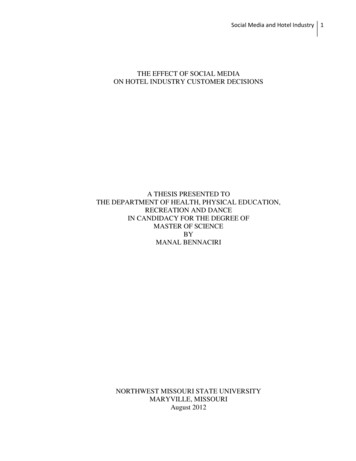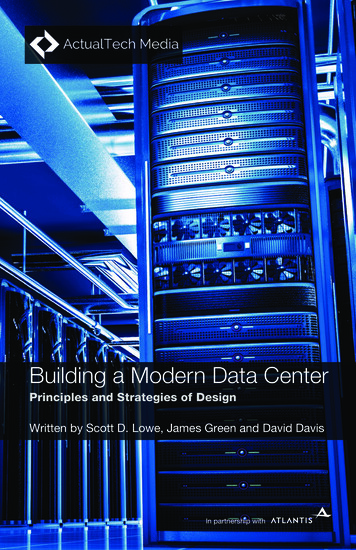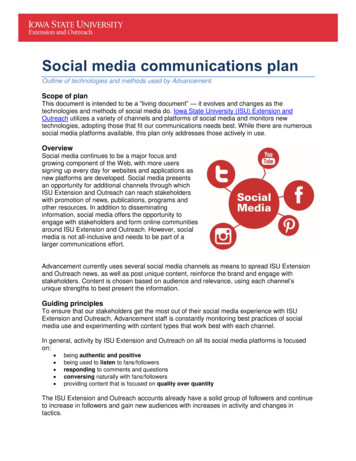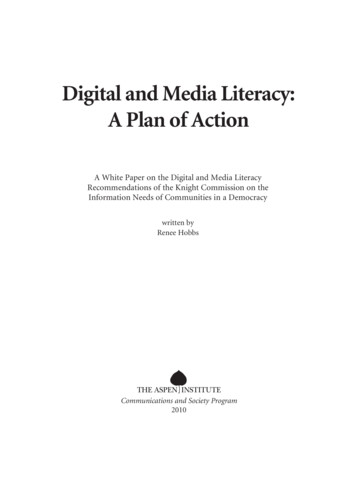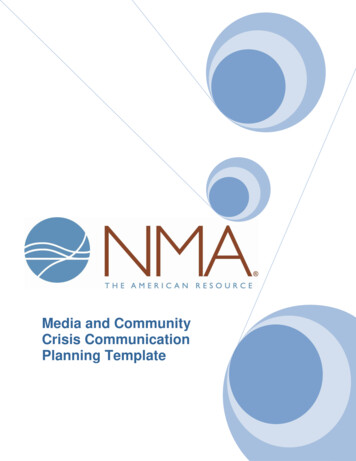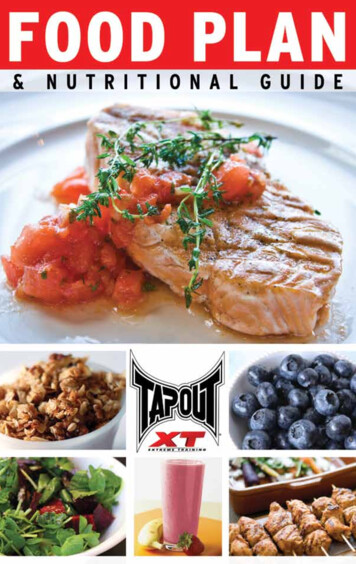
Transcription
IntroductionThis guide has been designed to help you to start thinking about precisely whatyou’re eating and why, so you can make better all-around food choices. Sinceall food is not created equal, a healthy diet is critical for a healthy mind andbody. Good nutrition provides all the energy, raw materials, and antioxidantsto keep us feeling younger, more resilient, illness free and better able to reachour transformation goals.We have all heard the adage that “you are what you eat” but what exactly doesthat mean? The obvious implication of course is that if we eat healthy food, wewill be a healthy person and if we eat unhealthy foods, we will be an unhealthyperson. While it is not quite that simple, there is some truth to the saying.Why do we eat what we do? Our food choices say a lot about who we are andwhat kind of life we lead. Do we eat breakfast each day? Do we like sweets? Dowe crave carbs? If someone opened your refrigerator right now, what wouldbe in it? Would it be packed with take-out or would it be filled with fresh food?Would it contain soft drinks or bottled water? Would it be filled with desserts orfruit? These are interesting behavioral questions.There are a host of additional questions that we can also ask about ourmotivation for eating, such as, when and why we eat. Do we eat because it’stime? Do we eat because we’re hungry? Do we eat because it tastes good? Theanswers to all of these questions will help us explore our precise relationshipwith food. It is a relationship that is vital to our health, our fitness level, ourpsychological wellness, our longevity and our overall quality of life.Each of us has a distinct food personality, and once we understand thestrengths and weaknesses of that personality, we can address the changes thatwe must make in order to use food to our advantage so we can achieve all ofour transformation goals.The information contained in this Food Plan and Nutrition Guide is not areplacement for the advice and consultation of a medical doctor or otherqualified health care professional. Please consult with your physician or otherqualified health care professional before beginning this or any other exercise orweight loss program. If you have any dietary restrictions or health conditions,please discuss the information contained in this booklet with your doctor inorder to make appropriate modifications to the suggested menus.TapouT is a registered trademark of ABG TapouT, LLC in the USA. TapouT is a trademark of ABG TapouT, LCC. 2012 ABG, TapouT LLC.
General Food EducationFood is essential for life. Food generates the fuel and provides the power that thebody requires to propel itself. Food also stimulates growth and development.There are five basic types of food that are an important component of goodhealth and a balanced diet:Protein (meats, beans, fish)Protein is an essential component of our diet, because it provides the aminoacids that we need to synthesize our own proteins. Protein feeds our muscles.It is a vital part of our hair, skin, cells, tissues and organs. Protein keeps our bodyrunning smoothly. It both heals and repairs injuries and helps us fight and resistdiseases. There are two different types of protein, those from animal sources(complete) which are high in essential amino acids and those from non-animalsources (incomplete) which are lower in essential amino acids.Good sources of complete proteins include lean beef, tuna fish, salmon, chickenbreast, eggs and milk. Sources of incomplete protein include tofu, legumes, yogurt,seeds, and beans.Good Fat (nuts, olive oil, avocados)Fats are important to a balanced diet, and we simply cannot live without them.They are a major source of energy and help with nutrient absorption. Fatsalso helps us maintain our body temperature, keep our skin soft and our hairshiny but some fats can contribute to weight gain and heart disease. Theseare referred to as “bad fats.” Bad fats (saturated and trans fats) raise bloodcholesterol levels which can block the flow of oxygen-rich blood to both theheart and brain. One key to a healthy diet is to replace bad fats with good fatsas often as possible.Good sources of “good fats”, monounsaturated fats, like olive oil, almonds, andpeanut butter as well as polyunsaturated fats like sardines, trout and soymilk.Fruit and Vegetables (melons, bananas, spinach)Fruits and vegetables contain many of the essential vitamins and minerals thatour bodies need for balanced nutrition including Vitamins A, B, C and E as wellas magnesium, iron, zinc, calcium and phosphorus. They also contain dietaryfiber which is critical in helping the body rid itself of toxins. The combinedbenefits of fresh fruit and vegetables include a reduced risk of heart disease,stroke, eye and digestive problems. The greatest benefits can be obtained byconsuming both a wide variety and varying colors of fruits and vegetables. Weare urged to “eat the rainbow”!Good sources of healthy fruits include melon, apricots, bananas, and strawberriesand healthy vegetables include spinach, cabbage, tomatoes, and carrots.45
Whole Grains (whole grain bread, brown rice, cereals)Grains are naturally low in fat, and they are good source of carbohydrateswhich we need for energy. Whole grains, which are unrefined grains, are a goodsource of fiber, potassium, magnesium, selenium and B vitamins like thiamin,riboflavin, niacin and folate. Consuming whole grains has been associated witha lower risk of heart disease, stroke and diabetes. In addition, with rich amountsof dietary fiber, whole grains also improve regularity. And since they are filling,we tend to feel full longer. They have also been an effective carbohydratesource for many weight loss and weight control regimens.Good sources of whole grains include bread, oatmeal, brown rice, whole wheatpastas, whole grain barley, popcorn, buckwheat, quinoa, wild rice, and bulgur.Dairy (yogurt, low-fat milk, low-fat cheese)Dairy foods are among the richest sources of calcium available to us andcalcium is critical for the health of our bones and teeth. As a matter of fact, milkis a leading source of calcium, phosphorus, vitamin D and potassium. VitaminD supports the absorption of calcium and plays a role in immune function, cellgrowth and inflammation reduction. Dairy foods are also another rich sourceof protein, magnesium and B vitamins. The many nutrients that dairy foodsprovide help the body function at an optimal level and lower our risk of avariety of health problems.Good sources of dairy include low fat milk, fat free milk, yogurt, cheese, butter, hardcheeses (like parmesan, aged cheddar, and aged gouda), cottage cheese, and frozencustard.Understanding CarbsCarbohydrates are comprised of sugars, starches and cellulose; and are vital to ahealthy diet. They provide energy for our daily activities as well as more intensephysical activity since they directly fuel our muscles. Like many nutritionalelements. carbohydrates must be eaten in moderation in order to maintainhealthy body weight.There are also two different kinds of carbs. The first kind, simple carbs(monosaccharides), are found in white bread, white rice, cake, soft drinks, candy,milk, syrups, and fruit. These carbs are broken down quickly by the body andprovide fast energy, but they are typically not a good source of vitamins or keynutritional elements. Simple carbs are infamous for providing the short-termenergy “buzz” and the subsequent “crash and burn” that we feel mere momentslater. Simple carbs are also more apt to leave us feeling hungry an hour or twoafter eating and can contribute to weight gain by inviting over-eating.The second kind of carbohydrate, complex carbs (polysaccharides) are starcheswhich are more naturally occurring and contain unrefined sugars. These carbscome in the form of more fiber-rich foods like grains, potatoes, oatmeal, wheat,rice, vegetables, legumes, and corn. Complex carbs are processed and broken6down by our bodies at a much slower rate than the fast-digesting, fast-energysimple carbs above.Complex carbs produce longer lasting energy and help improve digestion.Their slow release of glucose also helps stabilize blood sugar. After eating thesetypes of carbs, we are more likely to feel satisfied or full and it lasts much longer.When marathoners, cyclists and endurance athletes “carbohydrate load” beforea race, this is precisely the type of energy that they are seeking.So carbohydrates satisfy both the body’s short-term and long-term energyrequirements. They also provide fuel for the central nervous and the muscularsystem. Carbs are vital for anyone engaging in a regular exercise program sincethey directly impact stamina, performance and most important of all usableenergy.Understanding FatsFat is one of the three nutrients along with protein and carbohydrates thatsupplies nourishment to the body. Fat is an important source of energy andunlike carbohydrates, it does not cause fluctuations in blood sugar. Fat isactually an organic compound that is comprised of carbon, hydrogen andoxygen. While it is critical for certain body and cell functions, too much fat inthe diet can be very unhealthy.There are four types of dietary fat: saturated, trans, monounsaturated andpolyunsaturated. The first two are considered bad fats while the latter two aregood fats. Bad fats tend to increase cholesterol, triglycerides levels and obesitythereby increasing heart attack risk while good fats consumed in moderationcan actually improve heart health.Saturated Fats are those fats found in animal products like whole milk,ice cream, butter, and certain cheeses as well as coconut and palm oil. They canincrease “bad cholesterol” levels and increase heart disease.Trans Fats are often considered by doctors to be the worst type of fat. Transfats are rare in nature, but can occur in food production process (i.e. fried foods),and they raise bad LDL cholesterol levels and lower good HDL cholesterollevels. Trans fats are the leading dietary culprits in increasing the risk of heartattack, stroke, and type 2 diabetes.Monounsaturated Fats like olive oil and canola oil are liquid at roomtemperature but tend to turn solid when chilled or refrigerated. This type ofunsaturated fat can help lower cholesterol and are typically high in antioxidants.Polyunsaturated Fats stay liquid even when chilled and heated andprocessing can actually damage these types of fats. They include fish, fishoil and seafood which are packed with Omega-3 fatty acids and sunflower,safflower and soybean oils which are rich in Omega-6 fatty acids and reducethe risk of cardiovascular disease.7
Understanding ProteinsThere is no doubt that we need protein. Protein is required for the growth,maintenance, repair and strength of our bodies. It is our most abundantmolecule and plays an important role in all of our metabolic functions. Likecarbohydrates and fats, protein also contains carbon, hydrogen and oxygen,but proteins have an additional essential element, nitrogen, which forms thechemical components of amino acids, from which all proteins are made.Amino acids are the building blocks of protein and there are 20 different onesfound in our body. Humans, however, can only produce half of those found andthe rest must be obtained through food. Unlike excess fats, carbs and starchthe body does not store excess amino acids. There are ten essential amino acidsthat we must take in. Without even one of these “essentials” protein breaksdown and we can experience muscle loss, weakness, metabolic disruption,immune system collapse, and destruction of red blood cells.High protein intake is critical during an exercise regimen since it one of the keynutrients for muscle and strength building. It also helps the tissues that arebroken down during exercise regenerate.The recommended dietary allowance for protein is 0.8 grams per kilogram ofbody weight per day which is roughly 0.36 grams per lb. of body weight. Itaverages out to about 40-70 grams per day for the average person. Enduranceathletes, however, should consume more or about 1.2 to 1.4 grams per kilogram(2.2 grams per lb.) of body eight per day and someone engaged in strengthtraining would benefit from about 1.4 to 1.8 grams per kilogram (2.2 grams perlb.) of body weight per day.The Art of Eating in ModerationGone are the days when we could just eat about anything. Over time our bodieshave changed. Our metabolism is not what it once was. Weight has found away to collect on our bodies and stay, and it tends to settle in our hardest toreach places.We know that it’s not really the piece of donut that we sneak now and then atwork, the handful of fries that we had at lunch yesterday, or the small taste of pieon a holiday. It’s those extra bagels, the late afternoon lattes, or the mounds ofbutter and sour cream that we slap on an otherwise innocent baked potato. It’snot the pretzel or two, it’s the whole bag! It’s not the healthy salad, it’s the massof ranch dressing on top and the garlic bread on the side. You see, moderationis not just about portion control. It is about food choices, condiments, extrasand perhaps most importantly timing. We need to watch what we eat, howmuch we eat and precisely when we eat.What makes us over-weight is simply overeating. It’s variety of choices andactions that take many forms. We know we have to moderate, but how do wedo it?Five Very Simple Moderation Do’s:1. Eat only when you’re hungry. That’s right. Simple, isn’t it? Don’t eat becauseit’s time, because you’re bored or because you have not had anything in a fewhours. Ask yourself, am I hungry?Fish (3 oz., 21 grams)Tofu (3 oz., 15 grams of protein)2. You don’t have to finish it. Forget what your mother said. You are no longergrowing (at least height-wise). Finishing everything on your plate in ourportion oversized society will only make you fatter.Beef (3 oz., 21 grams)Peanut Butter (2 tbsps, 8 grams)3. Eat food naked as often as possible. How about the toast without but
4 5 General Food Education Food is essential for life. Food generates the fuel and provides the power that the body requires to propel itself. Food also stimulates growth and development.





